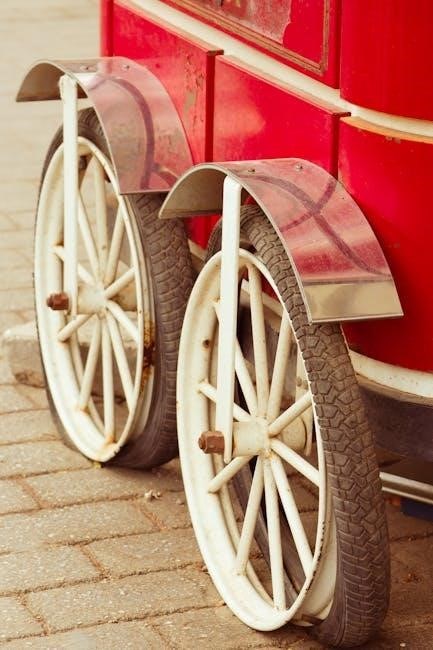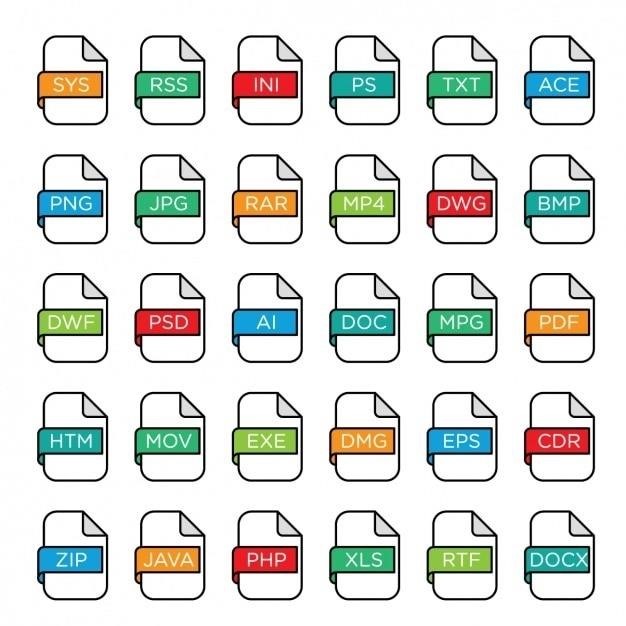Choosing the right golf cart tire size is crucial for performance, maneuverability, and comfort. This guide helps you understand tire measurements, fitment, and terrain-specific options to make informed decisions.

Understanding Golf Cart Tire Size Markings
Golf cart tire size markings are essential for determining the right fit. They typically include diameter, width, and sidewall ratio, ensuring proper performance and compatibility with your cart.
Standard Tire Size Measurements
Standard golf cart tire size measurements are typically expressed in inches and follow a specific format, such as 18×8.5-8 or 20×10-10. The first number represents the tire’s diameter, the second is the width, and the third indicates the rim size or bolt pattern. These measurements are crucial for ensuring compatibility with your cart’s wheels and axles. Proper sizing ensures optimal performance, stability, and safety. Always refer to your cart’s manual or manufacturer specifications to confirm the correct measurements for your vehicle. Using the wrong size can lead to poor handling or potential damage to the cart’s suspension and frame.
Metric Tire Size Measurements
Metric golf cart tire size measurements are expressed in millimeters and follow a different format, such as 205/50R15. The first number represents the tire’s width in millimeters, the second is the aspect ratio (tire height as a percentage of width), and the third is the rim diameter in inches. This system is less common for golf carts but is sometimes used for specialty or imported models. Metric sizes provide precise measurements, ensuring proper fitment and performance. Always cross-reference metric sizes with standard measurements or consult your cart’s owner’s manual for compatibility. Proper sizing is essential to maintain stability and functionality.
How to Calculate Tire Ratio
To calculate the tire ratio for your golf cart, use the formula: (tire height ÷ tire width) × 100. For example, if the tire height is 8 inches and the width is 10 inches, the ratio is (8 ÷ 10) × 100 = 80%. This percentage represents the tire’s height relative to its width. For metric sizes, the same formula applies, but measurements are in millimeters. Accurate calculation ensures proper fitment and performance. Always refer to the tire’s sidewall or owner’s manual for precise measurements. This ratio is crucial for maintaining stability and compatibility with your cart’s specifications.

Standard Golf Cart Tire Sizes
Standard golf cart tire sizes typically range from 18×8.5-8 to 20×10-10 and 23×10.5-12, ensuring optimal performance and proper fitment for most models.
Common Golf Cart Tire Dimensions
Golf cart tire dimensions vary, but common sizes include 18×8.5-8, 20×10-10, and 23×10.5-12. These measurements represent diameter, width, and rim size. The first number indicates the tire’s outer diameter, the second is the width, and the third shows the rim size. For example, an 18×8.5-8 tire has an 18-inch diameter, 8.5-inch width, and fits an 8-inch rim. These sizes ensure proper fitment and performance for most golf carts. Always consult a size chart or manufacturer’s specifications to confirm compatibility with your vehicle. Proper sizing is crucial for stability, handling, and overall safety.
Factors Influencing Tire Size
Several factors influence the appropriate tire size for a golf cart. The cart’s weight, including passengers and cargo, affects the required tire load capacity. Terrain is another key factor; larger tires may be needed for rough or uneven surfaces, while smaller tires suffice for smooth, flat areas. The number of passengers and frequency of use also play a role, as heavier loads demand more durable tires. Additionally, the cart’s intended use—whether for golfing, off-roading, or casual driving—impacts the ideal tire size. Manufacturer specifications and compatibility with lift kits or custom wheels further guide the selection process.

Modifying Golf Cart Tire Sizes
Modifying golf cart tire sizes enhances performance, aesthetics, or functionality. Upgrading to larger tires improves ground clearance and traction, while smaller tires optimize speed on smooth surfaces.
Using Lift Kits for Larger Tires
Installing lift kits is a popular method to accommodate larger tires on golf carts. These kits raise the vehicle’s suspension, increasing ground clearance and allowing for taller or wider tires. Lift kits are ideal for off-road use, enhancing stability on uneven terrain. They also improve aesthetics for those seeking a more aggressive look. However, it’s crucial to choose a lift kit compatible with your cart’s make and model. Incorrect installation can affect handling and safety. Always follow manufacturer guidelines or consult a professional for proper fitting.
Impact of Larger Wheels on Performance
Larger wheels on a golf cart can significantly impact its performance. While they enhance aesthetics and ground clearance, they may reduce acceleration and torque due to the increased wheel circumference. Taller wheels can also affect stability, especially at higher speeds, as the center of gravity rises slightly. Additionally, larger wheels may lead to reduced efficiency, as the motor works harder to propel the cart. However, for off-road or rough terrain, the improved traction often outweighs these drawbacks. Balancing style and functionality is key when upgrading to larger wheels.

Choosing the Right Tires for Your Terrain
Selecting the right tires for your golf cart depends on the terrain you frequent. Turf tires are ideal for grassy surfaces, minimizing damage while providing traction. For rough or uneven ground, all-terrain tires with deeper treads are recommended. Smooth surfaces like paved roads benefit from tires with less aggressive tread patterns, enhancing comfort and reducing wear. Matching your tire type to the terrain ensures optimal performance, longevity, and safety. Always consider your primary usage and environment when making your choice.
Tires for Turf and Grass
Tires designed for turf and grass are specifically engineered to minimize damage to delicate surfaces while providing reliable traction. These tires typically feature narrow tread patterns and smooth designs to prevent tearing or ripping of the grass. They are ideal for golf courses, residential lawns, or sports fields where maintaining surface integrity is crucial. Many turf tires are made with lightweight materials to reduce ground pressure further. For frequent use on grassy terrain, consider tires with flexible sidewalls and heightened durability to ensure long-lasting performance without compromising the health of the turf. Proper tire selection helps preserve aesthetics and functionality.
Tires for All-Terrain and Rough Surfaces
All-terrain tires are designed to handle rough and uneven surfaces, providing superior traction and durability. These tires feature aggressive tread patterns with deep grooves to maximize grip on dirt, gravel, or muddy terrains. Wider tires are often preferred for better stability and ground contact, reducing the risk of getting stuck. Durable rubber compounds and reinforced sidewalls ensure long-lasting performance. For golf carts used in rugged environments, all-terrain tires are essential to maintain control and comfort. They are ideal for off-road adventures, construction sites, or trails with varying surface conditions, ensuring reliability and safety in challenging landscapes.
Tires for Paved Roads and Smooth Surfaces
Tires designed for paved roads and smooth surfaces prioritize traction, comfort, and durability on hard surfaces. These tires typically feature tread patterns with closer grooves, minimizing wear and noise while enhancing grip on asphalt or concrete. Specially formulated rubber compounds improve stability and handling at higher speeds. For paved surfaces, narrower tires with higher air pressure are often recommended to reduce rolling resistance and improve fuel efficiency. Proper sizing ensures optimal performance, making them ideal for golf carts used primarily on roads, sidewalks, or golf courses with smooth terrain. This ensures a quieter, smoother ride and extended tire life.

How to Measure Your Golf Cart Tires
Measuring golf cart tires involves checking the diameter, width, and sidewall height. Use a tape measure to ensure accuracy and proper fitment for optimal performance.
Steps to Determine Current Tire Size
To determine your golf cart’s tire size, start by measuring the tire’s overall diameter using a tape measure. Record the measurement from the ground to the top of the tire. Next, check the sidewall for the tire size marking, typically in a series of numbers and letters. These markings indicate the tire’s width, diameter, and load capacity. Compare these measurements with a golf cart tire size chart to confirm compatibility. Always refer to your owner’s manual or a trusted tire guide for accurate sizing to ensure proper fitment and performance. This step is crucial for safety and optimal functionality.
Tools Needed for Accurate Measurement
To accurately measure golf cart tires, essential tools include a high-quality tape measure for determining diameter and circumference, and calipers for precise width measurements. A tire diameter gauge ensures accuracy, while a magnifying glass helps read sidewall markings. Wheel chocks or jack stands enhance safety by stabilizing the cart during measurement. A notebook and pen are handy for recording data. Optional tools like digital calipers or apps can aid precision. These tools collectively ensure accurate and safe measurement of golf cart tires for optimal fitment and performance.

Impact of Tire Size on Golf Cart Performance
Tire size significantly influences a golf cart’s speed, torque, and efficiency. Larger tires enhance stability and traction, while smaller tires improve maneuverability and reduce energy consumption. Proper sizing optimizes performance for specific terrain and use cases, ensuring a smooth and efficient ride. Accurate tire selection balances power, handling, and comfort, making it crucial for overall cart functionality and user satisfaction. Always consider terrain and intended use when choosing tire sizes to maximize performance and longevity. Proper fitting ensures safety and optimal operation of the golf cart under various conditions.
Effect on Handling and Stability
Tire size directly impacts a golf cart’s handling and stability. Larger tires provide greater stability at higher speeds and on uneven terrain, while smaller tires offer better maneuverability in tight spaces. Properly sized tires ensure even weight distribution, reducing the risk of tipping. Wider tires improve lateral stability, especially on slopes, but may compromise agility. Conversely, narrower tires enhance turning radius but might reduce traction on loose surfaces. Balancing tire size with cart weight and terrain ensures optimal control and safety, making handling and stability critical considerations for a smooth, reliable ride.
Influence on Ride Comfort
Tire size significantly impacts ride comfort in a golf cart. Larger tires with taller sidewalls absorb bumps more effectively, providing a smoother ride on uneven terrain. Smaller tires, while more efficient on smooth surfaces, can make the ride feel harsher due to less cushioning. Wider tires also enhance comfort by distributing weight more evenly, reducing vibrations. Proper tire pressure plays a crucial role, as underinflated tires can lead to a bumpy ride and increased wear. Balancing tire size with terrain and load ensures optimal comfort, making it essential to select tires that suit both the cart’s intended use and rider preferences for a enjoyable experience.

Understanding Offset and Bolt Pattern
Offset refers to the tire’s mounting position relative to the wheel hub, while bolt pattern describes the arrangement of wheel bolts. Both are critical for proper fitment and alignment, ensuring stability and performance. Incorrect offset or bolt pattern can lead to improper installation, affecting handling and safety. Always match specifications to your cart’s make and model for optimal functionality and to prevent potential damage or misalignment issues during operation or customization.
What is Tire Offset?
Tire offset measures the distance between the tire’s mounting surface and its centerline. It determines how the tire sits relative to the wheel hub, affecting handling and clearance. Positive offset means the tire is closer to the hub, while negative offset places it farther out. Zero offset centers the tire on the hub. Proper offset ensures optimal stability, alignment, and performance. Incorrect offset can cause uneven tire wear, reduced traction, or clearance issues with suspension components. Always consult your golf cart’s specifications to select tires with the correct offset for proper fitment and functionality.
Importance of Bolt Pattern Matching
Bolt pattern matching is critical for ensuring proper wheel fitment on your golf cart; The bolt pattern refers to the number and arrangement of bolts on the wheel hub. Mismatched bolt patterns can lead to improper seating, vibrations, or even wheel failure. Correct matching ensures safety, stability, and optimal performance. Always verify your cart’s bolt pattern before installing new wheels or tires. Consult your owner’s manual or manufacturer specifications to confirm compatibility. Proper alignment prevents damage to the axle and suspension, ensuring a smooth and safe ride. Accurate bolt pattern matching is essential for reliability and longevity of your golf cart’s wheels.
Upgrading Your Golf Cart Tires and Wheels
Upgrading your golf cart’s tires and wheels enhances performance, style, and customization. Modern designs offer improved safety, longevity, and better traction for various terrains. Proper fitment ensures reliability and optimal functionality, making it a worthwhile investment for both aesthetic and practical benefits.
Why Upgrade Your Tires?
Upgrading your tires offers numerous benefits, including improved performance, safety, and customization. Larger tires provide better traction on rough terrain, enhancing stability and control. Wider tires can improve ride comfort and reduce wear on your cart’s suspension. Custom tread patterns and unique designs allow personalization to suit your driving style and terrain. Upgrading also ensures compatibility with lift kits or larger wheels for a sleek, modern look. Additionally, high-quality tires last longer, reducing maintenance costs over time. Whether for off-road adventures or smooth rides, upgrading your tires elevates both functionality and aesthetics, making it a smart investment for any golf cart owner.
How to Choose the Right Upgrade

Choosing the right tire upgrade involves considering your golf cart’s usage, terrain, and personal preferences. Assess the surfaces you frequent—smooth pavement, rough trails, or grass—to select the appropriate tread pattern. Measure your cart’s current wheel size to ensure compatibility. Consider lift kits for larger tires, but check compatibility with your cart’s suspension. Budget is also a key factor, as high-performance tires may cost more. Lastly, think about aesthetics—custom designs or finishes can enhance your cart’s appearance. Always consult a professional to ensure proper fitment and performance for a seamless upgrade experience tailored to your needs.
Troubleshooting Common Fitment Issues
Troubleshooting fitment issues involves identifying mismatches in tire size, bolt patterns, or suspension compatibility. Always verify measurements and consult professionals to ensure proper installation and safety.
Identifying and Solving Tire Fitment Problems
Identifying tire fitment problems often starts with noticing uneven wear, vibrations, or difficulty steering. Common issues include incorrect tire size, mismatched bolt patterns, or improper suspension alignment. To solve these, measure tires accurately and cross-reference with your cart’s specifications. Ensure the bolt pattern matches your wheel hub, and consider using spacers or adapters if necessary. If tires rub against fenders or suspension components, check for proper installation or consult a professional to adjust or replace parts. Regular inspections and maintaining proper tire pressure can prevent many fitment-related issues and ensure smooth performance.
Common Mistakes to Avoid
When selecting or modifying golf cart tires, avoid common mistakes like ignoring manufacturer specifications or misinterpreting size markings. Many owners overlook the importance of proper bolt patterns, leading to fitment issues. Others assume larger tires automatically improve performance without considering suspension or ground clearance. Mixing tire sizes on the same cart can also cause instability. Always double-check measurements and consult compatibility charts before making changes. Neglecting regular maintenance, such as pressure checks, can shorten tire life. Avoid guessing sizes based on appearance; precise measurements are essential for optimal performance and safety.
Maintenance Tips for Longer Tire Life
Regular tire pressure checks, inspections for wear, and cleaning debris ensure optimal performance and longevity. Proper storage and avoiding harsh chemicals also preserve tire condition over time.
How to Care for Your Golf Cart Tires
Regularly cleaning your golf cart tires with mild soap and water removes dirt and chemicals that can degrade the rubber. Check tire pressure frequently, as under-inflation can reduce traction and increase wear. Avoid exposing tires to direct sunlight for extended periods, as UV rays can cause cracking. Use tire protectants or UV-resistant sprays to maintain flexibility. Store your cart in a cool, dry place when not in use. Avoid sharp turns or sudden stops, as these can strain the tires. Inspect tires for punctures or uneven wear and address issues promptly to prevent further damage.
Regular Inspection and Maintenance
Regular inspection of your golf cart tires is essential for optimal performance and longevity. Check the tread depth monthly, as worn tires can lead to reduced traction and stability. Look for signs of uneven wear, cracks, or punctures, which may indicate misalignment or debris damage. Inspect the sidewalls for bulges or cuts that could weaken the tire’s structure. Rotate tires every 500 miles to ensure even wear. Lubricate wheel bearings annually to prevent friction damage. Address any issues promptly to avoid costly repairs and ensure safe operation.
Selecting the right tire size for your golf cart is crucial for performance, safety, and longevity. Understanding measurements, calculating ratios, and considering terrain-specific needs ensures optimal fitment. Upgrading tires or using lift kits can enhance versatility but requires careful planning. Regular inspections and maintenance, such as checking tread depth and lubricating bearings, extend tire life. By following this guide, you can make informed decisions to maximize your golf cart’s potential. Whether for recreation or utility, proper tire selection and care will ensure a smooth, enjoyable experience for years to come.


